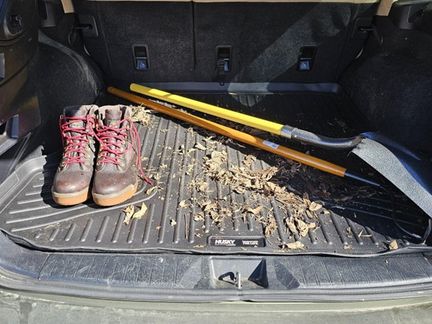What Is a Squatted Truck?
Updated on Feb 14, 2024
With a recent craze in the automotive industry–specifically trucks and SUVs–garnering media attention for its not-only concerning appearance but associated dangers and legislation, it’s only fair that the experts at RealTruck give our two cents!
Squatted trucks, also known as “tooted trucks” or “Carolina Squat,” refers to a series of modifications resulting in a unique and…questionable stance. This aesthetic involves installing a sizable front lift kit–often ranging between six and eight inches–while the rear suspension is left completely stock or even lowered, resulting in a significant reverse rake.
So where did this style originate and why did it gain popularity in the first place? Read on as we cover everything there is to know about squatted trucks.
Where Did Squatted Trucks Originate From?
Given the nickname “Carolina Squat,” you’d likely assume the style originated in the Carolinas; however, that’s only partially correct. While the term Carolina Squat, the cartoonishly broad height disparity from front to rear, and the affinity to install oversized wheels and low-profile tires likely originated in the Carolina area, the act of modifying your pickup with a reverse rake has long been popular in the truck scene, especially on the opposite side of the country.
Carolina Squat Vs. California Lean
Across the country, nestled up to the Pacific Ocean, lies the Golden State: California. It’s here that the styles of CenCal (central California), Cali Lean, and Baja-Stance began, all of which feature an iconic reverse rake. While not nearly as dramatic as Carolina Squat, these California styles are thought to have pioneered the stylistic choice; however, it’s crucial to understand the differences between these styles.
Firstly, Cali Lean, Cencal, and Baja-Stance trucks all pull inspiration from local Southern California races: the Baja 500 and Baja 1,000. The pickups that partake in these races, often referred to as prerunners, feature soft multi-link or leaf-sprung rear suspension setups to soak up high-speed bumps and “whoops” in the dirt; as a result, the trucks often sit nose-high. By comparison, Carolina Squat trucks sit nose-high for the sake of “style.”
Secondly, most Cali lean, Cencal, and Baja-stance trucks sit marginally lower in the rear–two to three inches–compared to Carolina Squat trucks, which often sit up to ten inches taller in the front due to sizable front lifts and rear lowering kits.
Thirdly, there’s a significant variation in styling outside of the reverse rake. Carolina Squat pickups often feature large-diameter wheels and low-profile tires, compared to Cencal trucks, which often feature small-diameter wheels and small tires, and Baja-Stance, which often feature small wheels and large tires for an off-road inspired appearance.
Additionally, Carolina Squat trucks often include accessories like roof racks, straight-piped exhaust systems, and CB radios with massive whip antennas mounted to the bed.
Lastly, we’ll touch on the preferred chassis. Most Carolina Squat trucks are early to mid-2,000-era Chevrolet Silverados and GMC Sierra half-tons. By comparison, most Cencal pickups are diesel ¾ and 1 tons, and common Baja-Stance trucks are Ford Rangers, F-150s, and even Broncos!
What Are the Dangers of Driving a Squatted Truck?
Squatted trucks are dangerous for numerous reasons; for starters, let’s discuss visibility. With such a massive height disparity, visibility over the hood is practically non-existent! Before the legislation was put into place banning squatted trucks, several accidents occurred in which a squatted truck owner rear-ended another vehicle or even struck a pedestrian due to poor visibility. Squatted trucks are also harmful to the visibility of other drivers due to the trajectory of the headlights; with such a sizable reverse rake, there isn’t enough adjustability of the headlights to aim at the road.
Additionally, such drastic suspension modifications and improper alignments are the perfect recipe for drivability issues, making squatted trucks outlandishly dangerous to drive on the road, especially at highway speeds.
Lastly, can someone say, “oil starvation?” Squatting your truck is terrible for the engine, causing all the oil to flow to the rear of the oil pan, typically not where the pickup tube is located. As a result, the oil pump can’t draw enough oil into the engine, leading to excessive wear and tear on the crankshaft bearings, timing components, cams, and cylinder walls.
The People Vs. Carolina Squat
Between 2021 and 2023, two states have banned “Carolina Squat” from highways; these include North Carolina and Virginia. The legislation cites the primary reason for the ban being safety, after a Virginia man was killed in an accident involving a squatted truck.
These laws define the style as any vehicle with a front ride height that’s four inches or greater than the rear, which led to a massive influx of drivers pouring into automotive shops to correct the now-illegal modification.
Current Updates
As of 2023, SB363 is nearing implementation, which would ban the modification from yet another state: Southern Carolina.
While several squatted truck owners fear that these laws pave the way for future bans, we’re not convinced. If any other modifications are banned, there’ll likely be a good reason, including potential danger to yourself and other drivers on the road. In either case, we’ll update this section as future laws roll out!
As always, for all of your favorite truck modifications, like complete lift kits or lowering kits, contact the experts!
Shop Now
RealTruck is your home for the best products to outfit your build for unforgettable adventures.
See Recent RealSource Articles Here...
- …
See More Guide Articles Here...
- …
More from SEMA...
- …
Join over 2 million RealTruck people
Get exclusive savings, insider information, and the latest RealTruck articles sent straight to your inbox.




